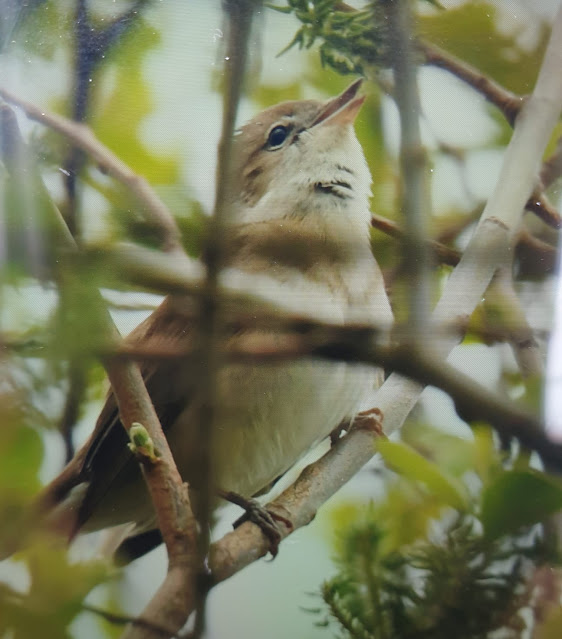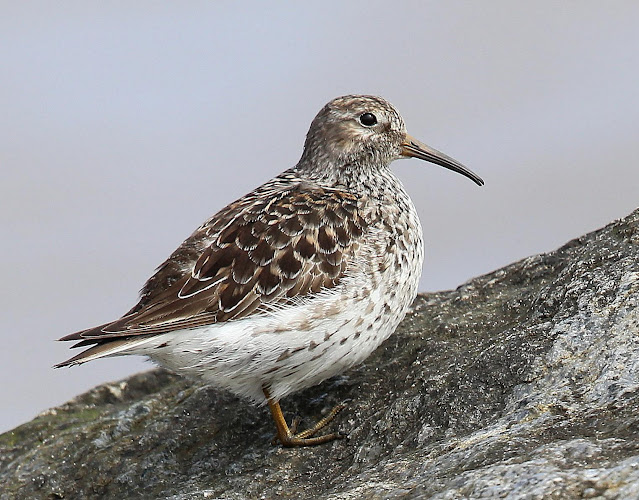With one or two fabulous exceptions, May turned out to be in large part a pretty miserable and cold continuation of April's conditions. Nevertheless there were a few bird spotting highs...
On the 1st several Reed and Sedge Warblers were singing along the Holmes Road, and two Grasshopper Warblers were also reeling on the patch. A Short-eared Owl was seen over the village, and 19 Whimbrel were still present in the farmland at the north end. The evening saw a small fall of Wheatears in the North Dunes - Colin counted 9.
Little Terns had also arrived, with an estimate of around 500 on the 2nd. Also on this date Mick had a high flying Black-tailed Godwit going south - the second record of this rare bird for here this year.
Tern passage continued on the 3rd with Maynard noting Common, Arctic and Little moving north, as well as a Ring Ouzel in the South Dunes. On the same day we had a really big passage of Hirundines - all mostly going south, as they usually do in spring here! Pat saw a Short-eared Owl and 3 Yellow Wagtails in the North Dunes that morning too, and Sean had a flyover Canada Goose in the valley.
Just before mid-day news came out that a Pallid Harrier had been seen up the coast at Waxham, and it was heading south. In the vague hope it might get to us, Sean headed into the North Dunes and sat on a hill, and Pat and Tim stationed themselves inland at the end of Low Road, as we have noticed that many southbound raptors seem to cut inland when they reach what we call 'the Warren' (a patch of rather open scrubby land west of the fence-line about half a mile north of the village). An hour's skywatching produced 4 Red Kites and a host of Buzzards to entertain us, but there was no sign of the Harrier, so Pat and Tim went home and Sean got to his feet and started to wander slowly further north through the dunes. We assumed the Harrier had either taken another route or whizzed through very quickly before we could get ourselves into position. However, amazingly, just before 1pm, over an hour after it was first reported, the Pallid Harrier appeared, sailing casually and elegantly across the dunes, riding the wind with effortless ease, and even deciding to take a detour east to dance over Sean's head before heading back inland and drifting casually into the Warren, just has we had predicted it might! Sean immediately sent a photo via WhatsApp to our local group, and within about ten seconds Pat had called for further information. "Get back to Low Road, it's flying really casually and dawdling, and it's heading through the Warren" Sean shouted down the phone, so Pat whizzed back and amazingly also saw it as it glided across the farmland. It then headed on, on a more inland route, and was seen once more, further to the south of us. Incredibly, later analysis of the photos showed it was the same bird that had been on Bryher, in the Isles of Scilly, just a few days before! It was a very special encounter with a really wonderful bird, and we must thank Will Walmsley and Robert Smith for putting the news out so promptly.
Some of Sean's Pallid pics:
And here is an atmospheric pic taken by Pat as it crossed farmland on the west side of the village:
Back down to earth on the 4th a Swift appeared in the valley in the rain that morning, and very annoyingly a Bearded Tit flew over, pinging away, but Sean was unable to actually see it because of raindrops on his binoculars and glasses!
On the morning of the 5th there were 2 Ring Ouzels in the valley, whilst the Iceland Gull was still here, on the south beach along with a summer plumaged Dunlin and a large party of Ringed Plovers. The Peregrine was seen on the east side of the church tower, and remained with us throughout the month again.
On the 6th Sean attempted the first Breeding Birds Survey visit for the square which covers the first km of the North Dunes, and almost got frostbite trying to fill in the paperwork. A Cuckoo calling was the highlight of the visit. Later in the valley Mick had 4 Ring Ouzels and a cracking male Redstart which stayed for the next few days, proving to be a master of the vanishing act for the majority of the time it was here, although eventually most of us managed to see it.
On the 7th Mick S, one of our very regular visitors, had 2 Spoonbills flying south, but annoyingly none of us managed to get on to them. They are a difficult year tick here!
Meanwhile Lesser Whitethroats, Cuckoos and Ring Ouzels were still in evidence, with at least 5 Ouzels in the valley that morning, and Maynard had a Hobby in the North Dunes. Sean had a calling flyover Woodlark in the valley too, the first of the year.
On the 8th Maynard was lucky enough to see 4 Black Terns come in off, and Sean had Hobby and the Redstart in the valley, and the first significant arrival of local Swifts happened that evening, with quite a few flying around over the village.
On the 9th there were two Spotted Flycatchers and a Whinchat in the valley, and a steady passage of Yellow Wagtails moving south with Pat counting 19 from the Plantation and Sean 6 in the valley. Up at the north end the Whimbrel were still present, with Tim counting 30, and also seeing two Woodlarks going south.
On the 10th Spotted Flycatcher and Ring Ouzel remained for us locals, but once again we all managed to miss the best bird, a female Red-footed Falcon which Mick S saw as it whizzed south along the dune tops at the Plantation. We really must try harder! Mick's photos below.
On the 11th Tim had a Garden Warbler back at its usual territory and the rest of us caught up with it over the next few days.
In an indication of how cold it continued to be, there were still a few Purple Sandpipers around at this point in the month too, and Tim took this fine picture on the 13th.
On the 16th there was a Common Sandpiper on the north beach amongst the groynes, and Tim and Mick were lucky enough to see a Turtle Dove whizzing south at speed from the Plantation.
On the 18th Sean saw a Black Redstart and a late Redwing in the South Dunes.
On the 19th Sean had a tussle with this plain Acro in the valley which was resolutely silent and mostly refused to give itself up, although eventually he did get a couple of shots. A tentative identification was concluded on the balance of probabilities, but readers' comments are always welcome!
On the 20th Barry had another Common Sandpiper and later Tim and Mick had 2. There was also a Red-breasted Merganser on the sea. Mick had 2 Canada Geese on the sea too! Sean's nocmig recorder picked up a Little Grebe over the house at 1.21am the previous night. That evening Pat had an Arctic Skua during a short seawatch.
The cold weather continued and a Spotted Flycatcher in the Totem Pole bushes on the 21st was a sad sight as it huddled out of the wind with not a single insect to be had for its breakfast.
On the morning of 22nd the (or a) Peregrine was hunting in the valley, and the Red-breasted Merganser was flying up and down the south beach. Lesser Whitethroats remained in the valley, hopefully breeding, but they were not singing at all so were often difficult to track down.
At least 2 more Spotted Flycatchers were present in the valley on the 23rd and another on the 24th. On the morning of the 25th, as cold weather continued, Sean saw two Hobbies sitting on the beach. When dog walkers came past they only flew a short way and landed on the sand again. This was surely rather worrying behaviour and we feared that the lack of insects was really having an impact on them. We have heard of Hobbies dying of starvation in the UK this year...
On the 26th Mick had 2 Knot on the sand bar and 2 Arctic Terns flying north. On his way back from the seawatch he found another Spotted Flycatcher in the dunes near the houses off North Market Road.
As the month ended breeding seemed to be getting underway for most species and several more Red Kites were seen, and as the weather finally began to show some incipient signs of warmth, butterflies and dragonflies at last began to emerge. It turned out to be a great month for both Green Haistreak and Brown Argus, and on top of those quite a few Walls, Painted Ladies and other moer common butterfly species were seen.
On the 29th Pat had 3 Avocets and a Green Woodpecker from the Plantation, plus a Woodlark south, and Sean caught up with the Avocets a couple of days later.
Fittingly for this month, it ended with another great bird being found by another visiting birder. This time it was Drew's turn to find this beautiful female Red-backed Shrike in the classic 'shrike bushes' north of the concrete blocks. It was a tricky bird to see, but eventually we all managed. A male was also present a short way up the coast at Waxham, and we would have our own male a few days later, but that's the story of another month (where Drew will also play his part!). Here are his own photos of his excellent bird.
And one from Tim:
And what of Mays of yore? I hear you say... Here's three of Peter's accounts from last century to finish off with.
Good patch birding everyone!
1989




























